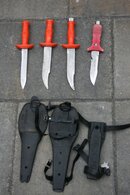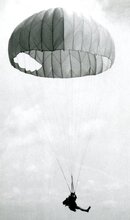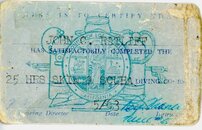'Sorry, but I still prefer a dive knife. My current one is a Wenoka dive knife, on my right calf. I've been using this arrangement since I started diving in 1959, and have used it in many, many different situations. I routinely cut fishing line I become entangled with in the Clackamas River, and know where that knife is located. I've lost it once, but came back and found it the next day on a subsequent dive. I've used it as a USAF Pararescueman to cut two dead Korean pilots out of their parachute lines, which were draped all over them after a crash into the Yellow Sea. I've used it to cut a 3 inch diameter rope of a boat's prop early in my diving (try that with shears), using the serrated edge. I also use the knife tip to dig lead sinkers out of crevices in the river's rocks.
One disadvantage of the shears is that they are really small, and hard to handle with thick neoprene gloves on (water temps here are sometimes in the 40s and 50s F.). Shears would be almost impossible to handle in heavy gloves or three-finger mitts. I don't think the shears would be a tool for digging out lead from the rocks too.
So I'll stay with my dive knife.
By the way, one of the reasons for the metal top on the dive knife handle is to use it as a signaling device on our steel tanks. But now, no metal top, and aluminum cylinders.

SeaRat
PS, note the line cutter on my Wenoka knife, the button keeper, and the serrated edge. I keep these knives razor sharp, and use the knife on almost very dive. I once a year or so ago picked up a nylon line, finding a throw weight on the end of it (probably used by the Sheriff for throwing practice in lifesaving training), and had the line wrap around my thumb. In the current, I was caught as the upstream part of the live was caught on a rock, and the line was tightening on my thumb in the high current area. I pulled out my knife quickly and in one swing parted this line, alleviating the pressure on my thumb in a second. I'm not sure I could have done that with a line cutter.
PS2, 'good discussion topic. It brings out some of the history of dive knives, and the reason I still prefer them.








